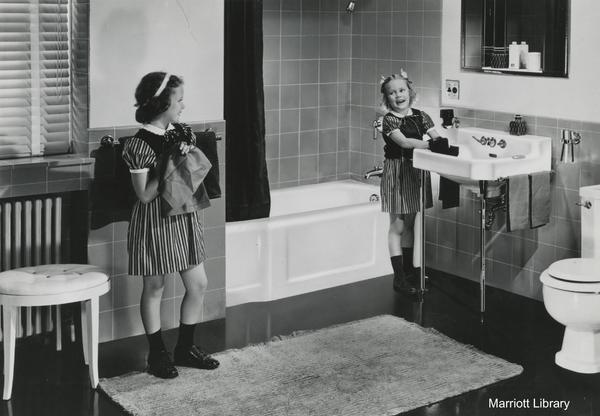Dublin Core
Title
Description
At the turn of the twentieth century, just 1% of homes in the United States had electricity and indoor plumbing. This number increased in the 1930s when federal funding and improved technologies made running water much more accessible for homeowners. Advancements such as flushing toilets, hot water, and steam heating became standard in urban houses and apartment buildings, easing the burden of housework for many Utah women. Even as costs lowered, however, these modern luxuries were unevenly distributed. They primarily benefited middle-class city dwellers, leaving many rural Utahns without access to running water well into the 21st century.
In the early 1900s, cities invested thousands of dollars into plumbing new housing developments and connecting homes to sewer systems. These changes were especially important in dense, urban areas because easy access to clean water helped ward off disease in crowded neighborhoods. Buildings such as the Hillcrest Apartments in Salt Lake City boasted modern amenities aimed at cleanliness and convenience. Steam-heated closets that dried clothes, flush toilets, and hot water on demand eased household tasks for women who no longer had to cart their own water from a well each morning.
For those who were wealthy enough to live in newer buildings, running water quickly went from a luxury to a necessity. But such updates were slow to arrive to many areas of rural Utah. New constructions often outfitted homes and commercial buildings with the appropriate pipes and connections to public water. But for existing buildings, such upgrades could be costly, if they were able to connect to a water source at all. Cities enacted ordinances that required homeowners to pay for permitting and inspections before installing plumbing infrastructure in their homes. This financial burden prevented many interested residents from updating their homes.
For some Utahns, running water is still its own luxury. Despite the major improvements that indoor plumbing made for domestic life, advancements did not reach every community in Utah. Members of the Navajo Nation residing in southeastern Utah, for example, continue to face poor water infrastructure and limited access to running water -- well into the 21st century.
Creator
Source
_______________
See Roger Roper, “Homemakers in Transition: Women in Salt Lake City Apartments, 1910 - 1940,” Utah Historical Quarterly (vol. 67, no. 4), Fall 1999, page 349; Alysa Revel, “Old House Kitchens and Baths: Giving Modern-Functioning Rooms an Historic Look,” Utah Building Preservation: Building on the Past (vol. 10), 2006, page 32; “Plumbing Indicates Progress of City,” Salt Lake Tribune, January 7, 1914; Joseph W. LaBine, “Slums Must Go! Says Straus,” Iron County Record, December 23, 19337; “Utah Historic Buildings Collection: Centennial Home,” Utah Division of State History, Ian James, “The Navajo Nation’s Wait for Water Persists with Few Answers,” AZ Central, July 22, 2020; Sydney Lasike, “Study Finds Utah Indigenous Women Lack Clean Water and Internet Access,” UPR Utah Public Radio, July 12, 2022; Zak Podmore, “For Many on the Navajo Nation, Getting Water Requires Travel, a Wait in Long Lines, and Lots of Patience,” Salt Lake Tribune, July 27, 2020.

